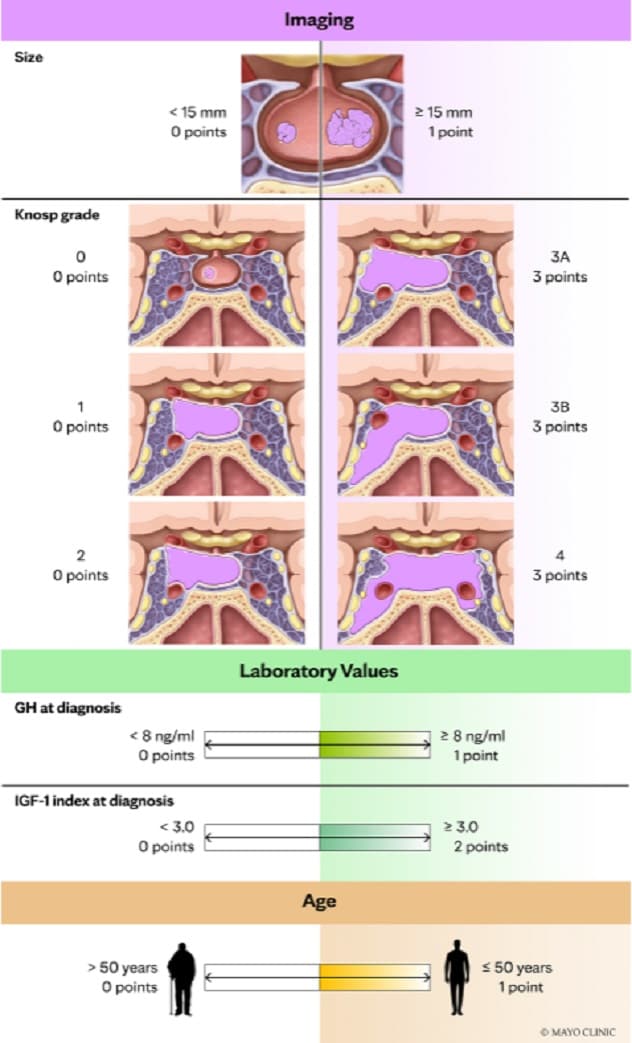April 09, 2024
Growth hormone (GH) excess presenting as acromegaly in adults and gigantism in pediatric patients most often occurs as result of pituitary adenoma. GH-secreting pituitary adenomas represent about 15% of all pituitary adenomas, with an annual incidence of roughly 4 cases per 1 million people and a prevalence of 60 per million.
Dana Erickson, M.D., of Endocrinology, Diabetes, Metabolism, and Nutrition at Mayo Clinic in Rochester, Minnesota, notes, "Despite increased awareness, this condition continues to be diagnosed in later stages and frequently as macroadenoma (70% to 81%), with cavernous sinus invasion by radiologic assessment in up to 35% of people with the condition."
Surgical management is the primary treatment modality, aiming for long-term biochemical remission. Reported long-term remission after surgery varies between 30% and 85%, with only a handful of identifiable preoperative factors linked to this outcome.
 نظام التقييم
نظام التقييم
يتوقع نظام التقييم المبتكَر هذا الهَدْأة الكيميائية الحيوية لدى المرضى المصابين بأورام غُدّية تفرز هرمون النمو الخاضعين للجراحة بطريق الوتدي.
Salomon Cohen-Cohen, M.D., a Neurologic Surgery resident, and Jamie J. Van Gompel, M.D., a neurosurgeon, both at Mayo Clinic in Rochester, undertook a study with the objective of designing a practical scoring system that could be used in the preoperative setting to identify patients with the highest chances of achieving remission following transsphenoidal resection. The results were published in World Neurosurgery in February 2024.
The retrospective analysis used a subset of patients with GH-secreting tumors surgically treated at Mayo Clinic in Rochester, Minnesota, between 2000 and 2015. This period was chosen to allow adequate long-term follow up and was prior to the widespread application of median wall resection technique.
Of 230 patients with de novo surgically treated GH-secreting adenoma in the database, 68 patients with detailed clinical and pathological information were included. Of note, those with plurihormonal clinical production or staining on immunohistochemistry were excluded. An IGF-1 level within normal range for age and gender and if available, suppression of GH to less than 1 ng/mL following oral glucose tolerance testing indicated biochemical remission.
Thirty-three (48.5%) patients were female and 55 (81%) patients had macroadenoma. Mean preoperative IGF-1 index (IGF-1 value divided by upper-limit normal IGF-1 for age and gender) was 3.09; mean preoperative GH was 8.1 ng/mL. Knosp-Steiner grading classification was applied.
Mean follow-up time was 88 months. Long-term remission of acromegaly occurred in 48% of patients, of whom 62% had Knosp-Steiner grade 0 to 2 at diagnosis and 15% had Knosp-Steiner grade 3A to 4.
Preoperative factors significantly associated with persistent disease and used in the scoring system were:
- Larger adenoma (≥ 15 mm).
- Presence of cavernous sinus invasion on MRI (Knosp-Steiner grade ≥ 3A).
- GH level (≥ 8 ng/mL) and IGF-1 index (≥ 3.0).
- Age (≤ 50 years at diagnosis).
A score of greater than 3 of 8 total points was identified as a cutoff associated with potential long-term remission.
Dr. Erickson adds, "This practical and relatively simple-to-use scoring system derived from four distinct preoperative parameters provides clinicians with a valuable tool for predicting postoperative outcomes. This importantly will allow the surgeon and the endocrinologist to counsel patients on likely need for adjuvant therapies, hopefully improving their follow-up and adherence."
For more information
Cohen-Cohen S, et al. A novel preoperative score to predict long-term biochemical remission in patients with growth-hormone secreting pituitary adenomas. World Neurosurgery. 2024;128:e822.
Refer a patient to Mayo Clinic.